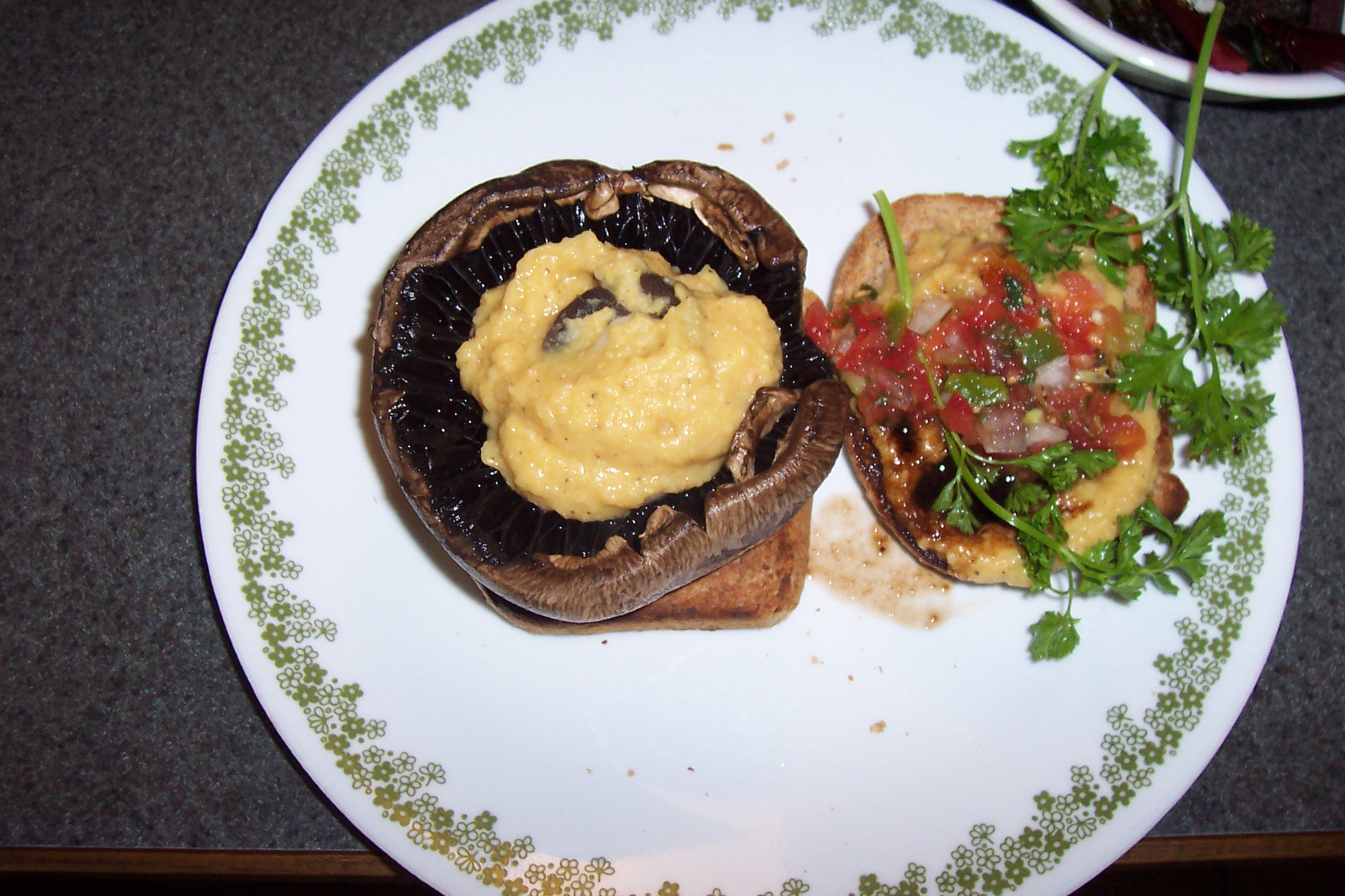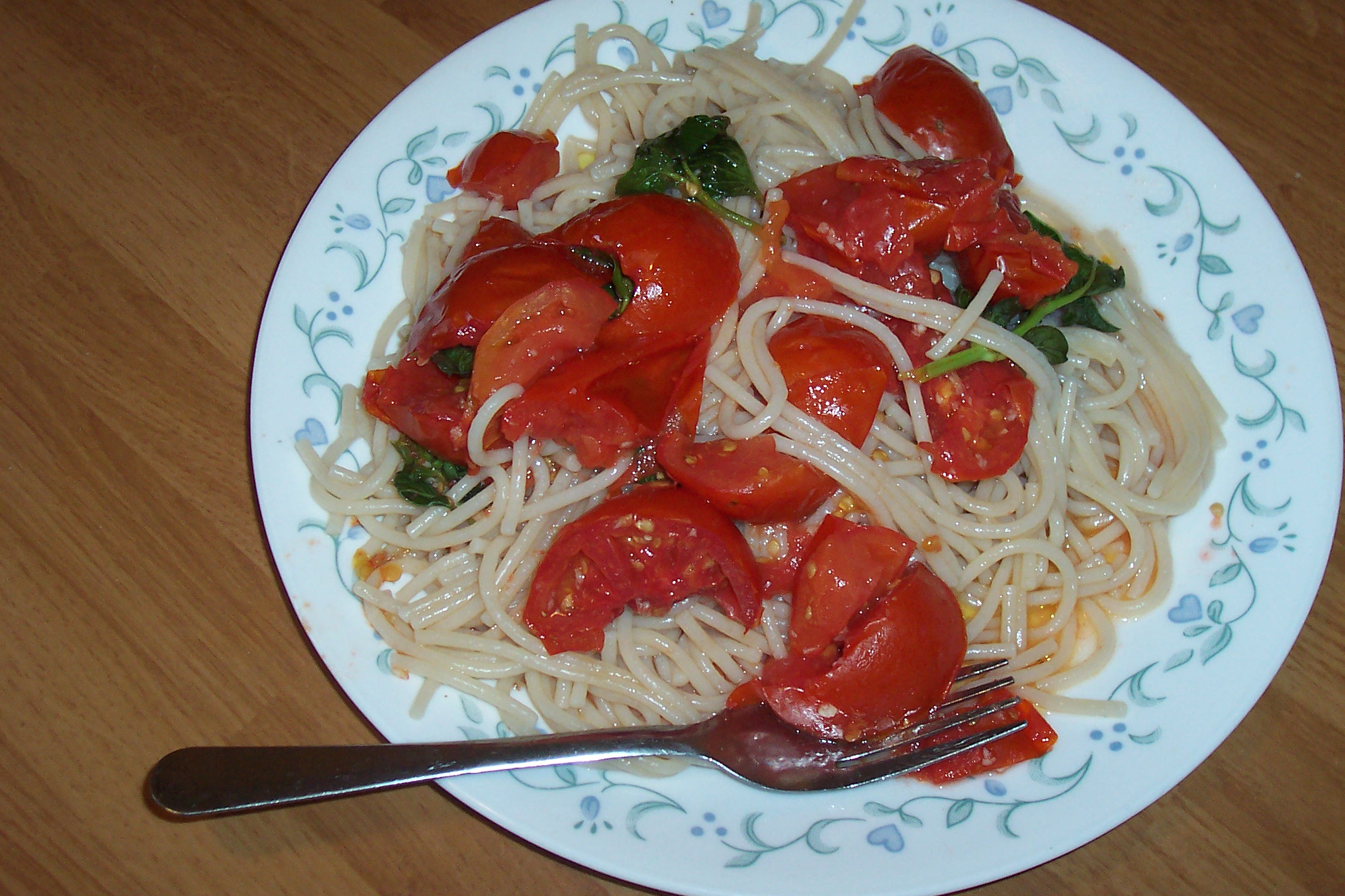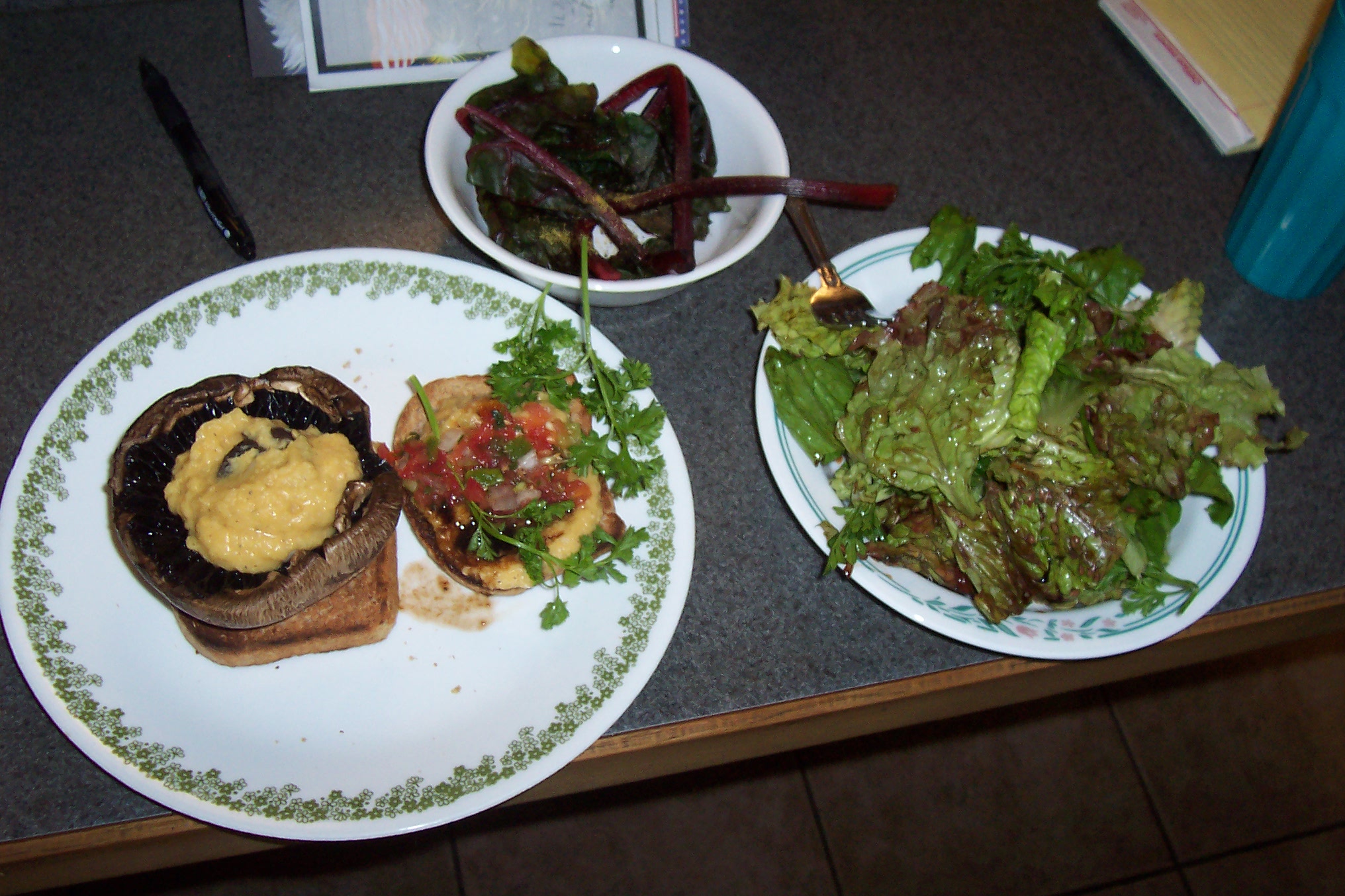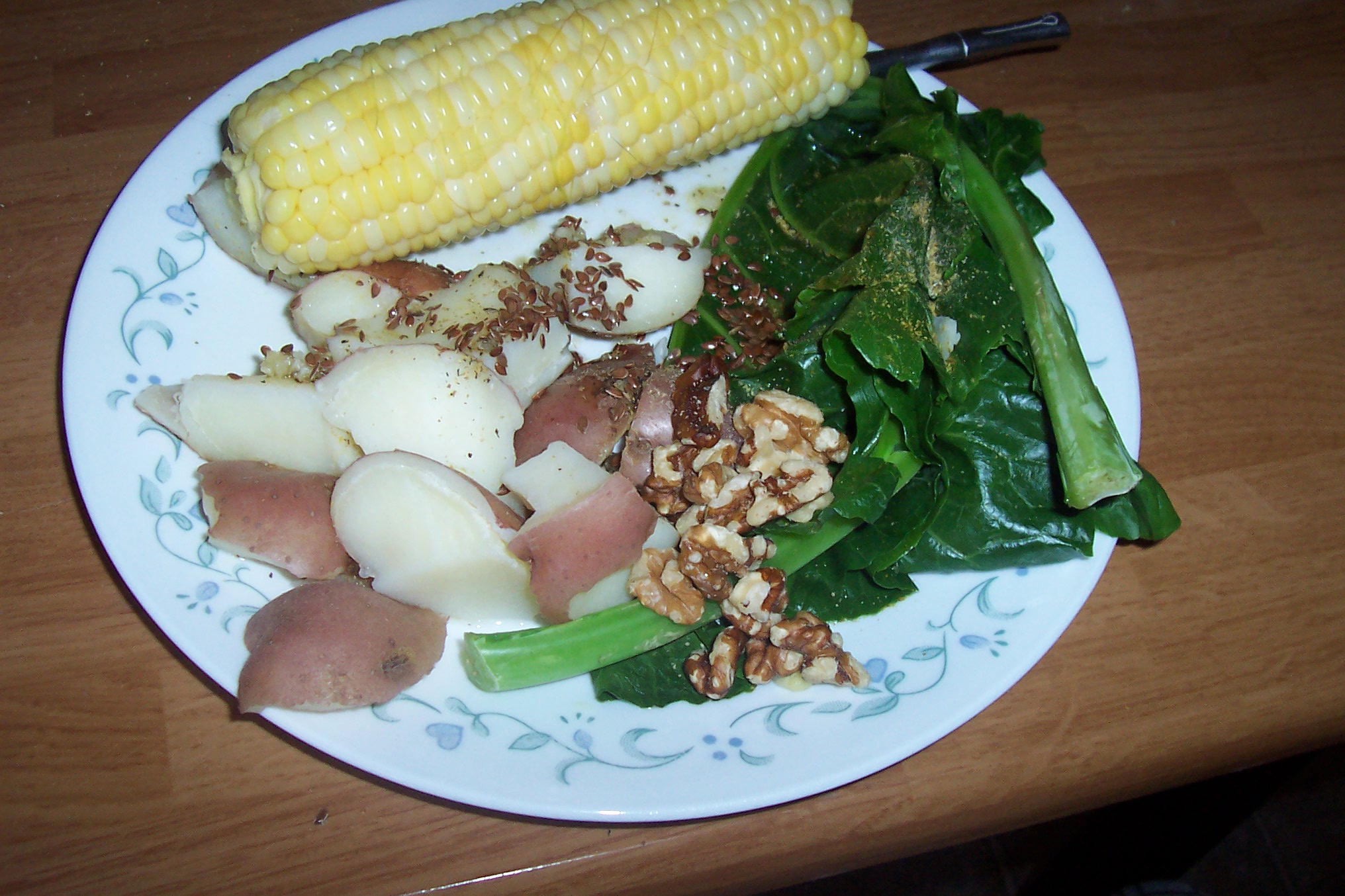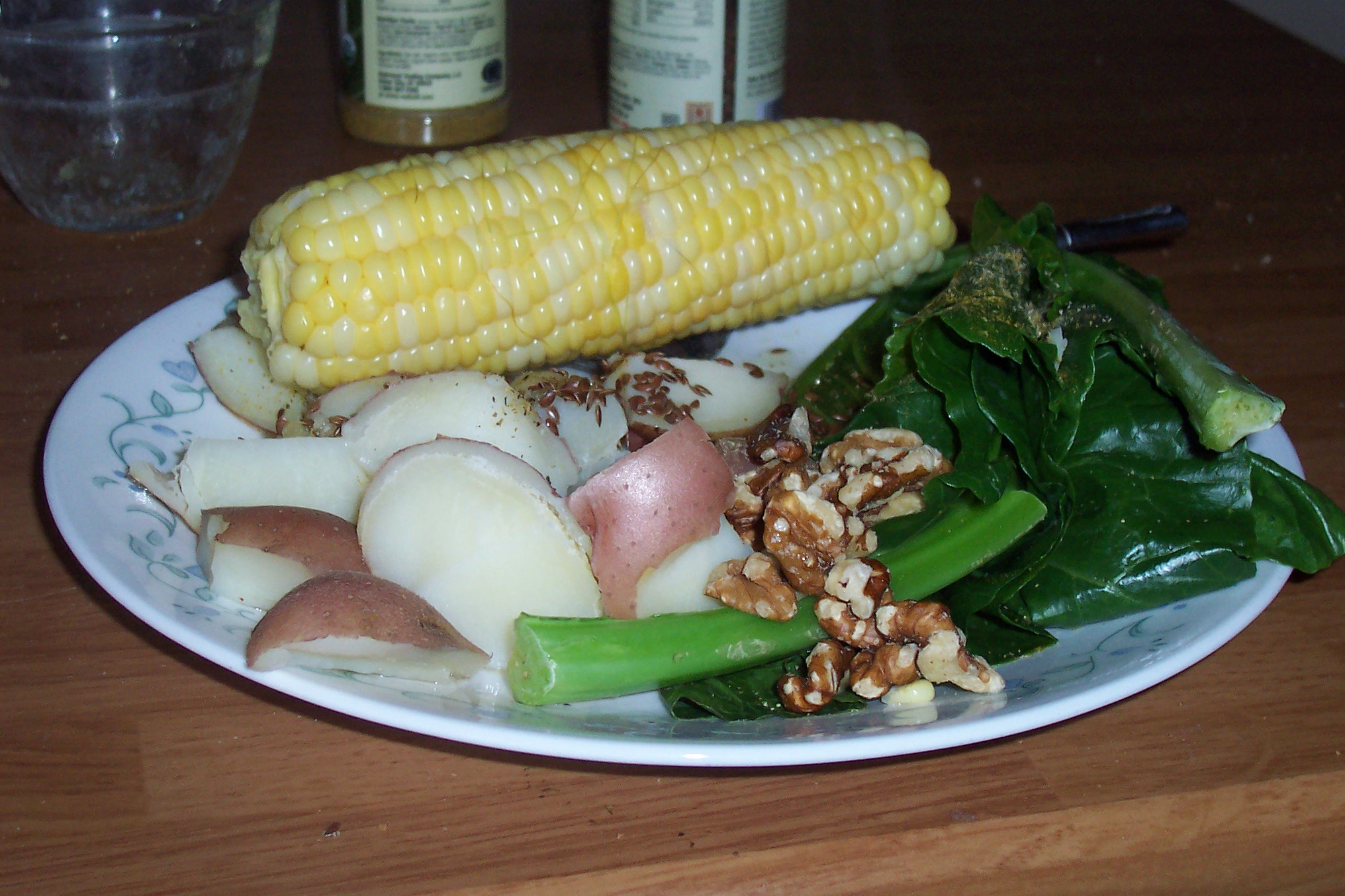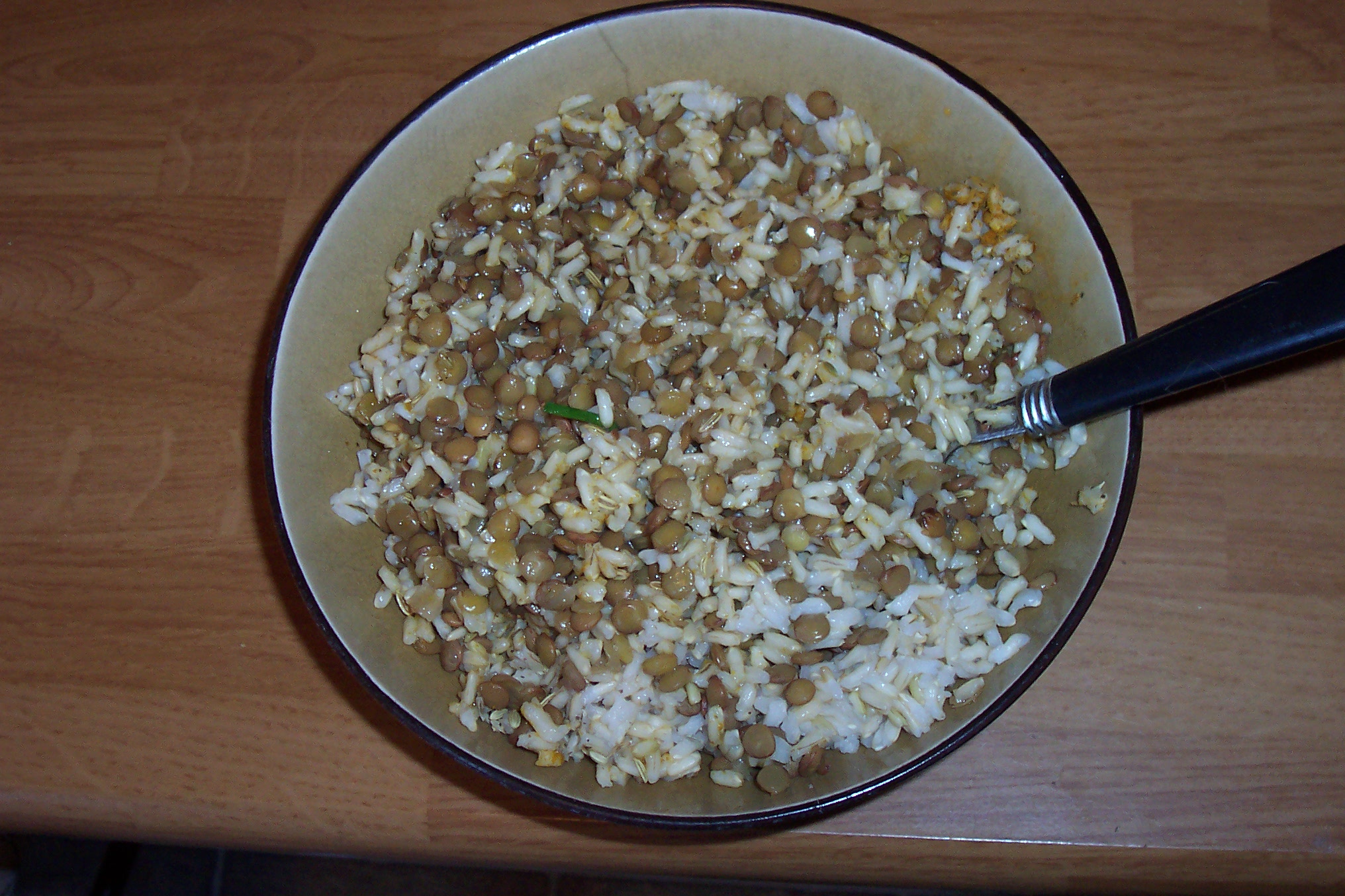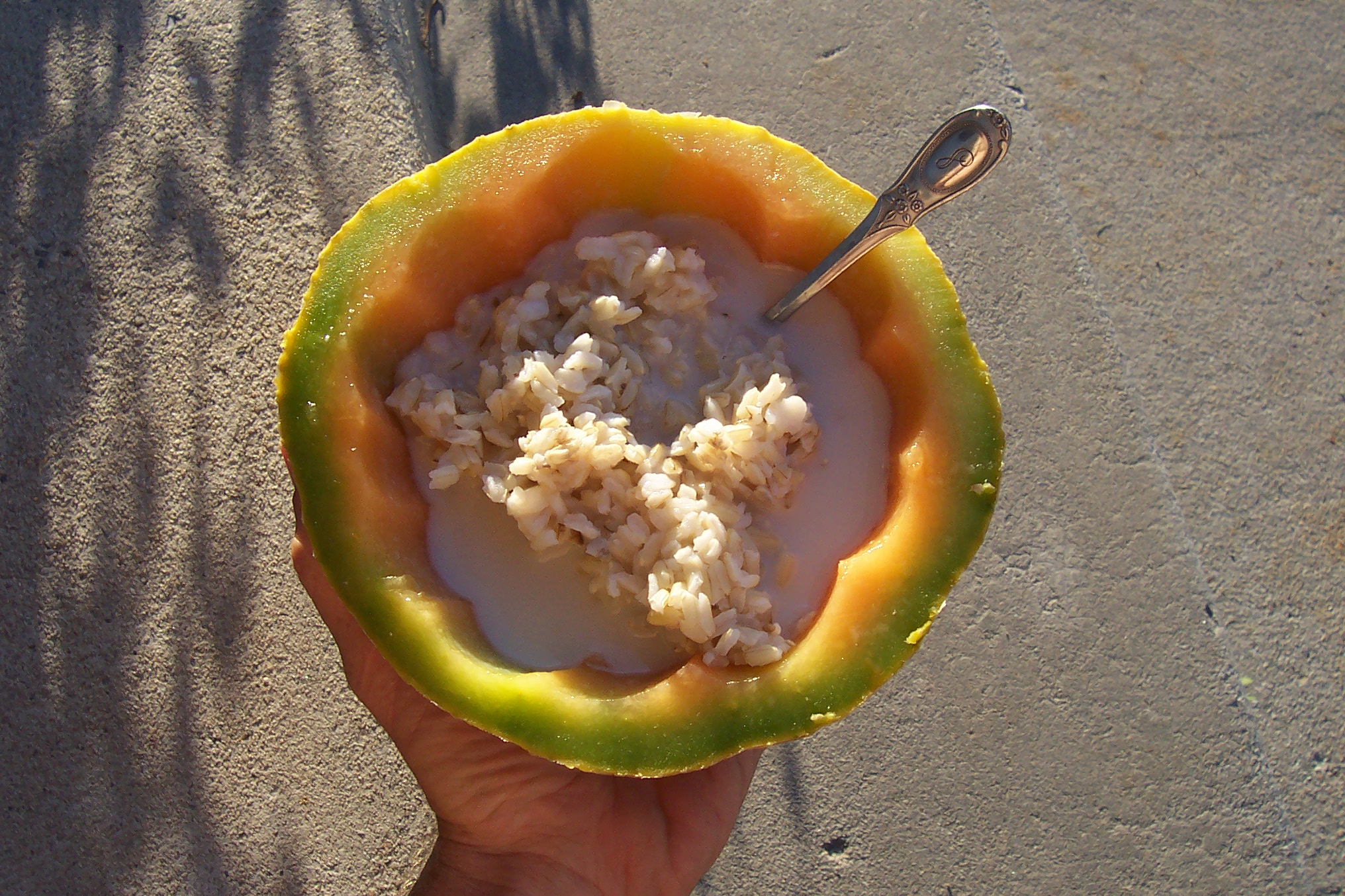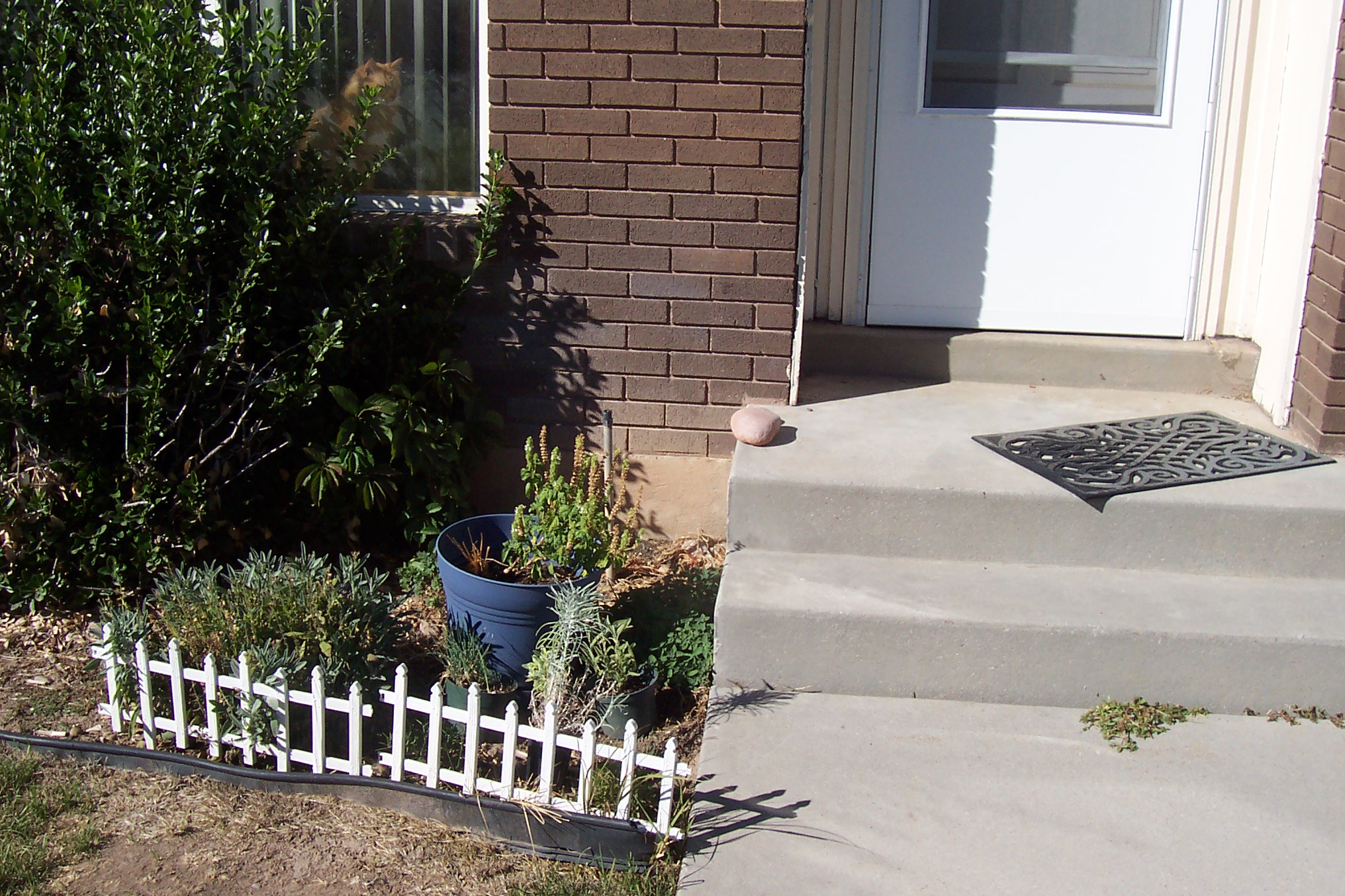The following legume cooking tips will make them softer, and will also help to prevent digestion problems:
*Soak legumes overnight prior to cooking.
*Drain and rinse for at least 30 seconds.
*Cook for two hours on medium flame/heat (maybe just one notch below medium).
*Be sure to add enough water to prevent scorching.
*Add cooking salt only after beans are tender, (roughly 90 minutes into cooking).
Greetings,
I appreciate the feedback provided about my first book, The Wellness Diaries. This is always appreciated. One of the most consistent feedback points received, was that The Wellness Diaries inspired a person to make change, but the concept itself so broad and often times, leaving one wondering what to do.
So, I have spent some time working up this step-by-step guide as a companion to The Wellness Diaries, available as a page on this website, (or e-pamphlet) for everyone. Naturally, this will make more sense if you have read the book.
This is a basic example, a foreshadowing appetizer of a course that I intend to offer in 2016 already in the works, about which I will definitely keep all of you posted right here! This step-by-step guide will help you prepare for that course. Stay tuned!
This guide is intended to be used with your involvement and work. Get a wellness diary of your own and track your progress. You will get from this what you put into it. Each step is deliberately placed. It is most effective to follow the steps with the corresponding exercises.
I have been through some interesting things. I have a lot to say; and although I have studied these topics a lot on my own, I am not a doctor. The appendix of Wellness Diaries includes the doctors’ books and websites recommended regarding info about plant-based diets, and other things pertaining to topics in the books. People are always encouraged to educate themselves. This step-by-step guide is solely intended for educational purposes and is not intended to diagnose, cure, treat or prevent any disease. If you are ill, please seek the help of a medical professional.
Outline:
*Plant-based diet
*Exercise and activity
*Find your prefered sleep amount and time
*Time outside
*Time among nature
*Unplug regularly
*Be inspired, feel alive. Live on purpose!
If you have read The Wellness Diaries, you are aware that adopting a plant-based diet was my essential first step toward wellness. I make the details of why this is, clear in the book and so I won’t do that here. In the Wellness Diaries appendix, I give an ample supply of resource material to research Nourishment Via Nutrition for yourself. Again, I encourage you to do so. Here, I simply give steps to take, and even some food ideas!
This is because at some point, you just have to try eating plant-based. Try the plant-based diet for two weeks, 14 days as I did in the book. You will find that you feel good; you begin to lose weight, and become more yourself. Throughout this process while reading The Wellness Diaries, and this guide, keep a wellness log. Carefully monitor your progress, your food, how you feel, look and any new happenings in your life. It’s great to look back and see it on paper; this is the proof that you can do it! However, you won’t know until you try.
Step 1: 14 days eating a plant-based diet
Set a date when you will try the totally plant-based, (vegetarian) diet for two weeks. Set the exact days you intend to do so, and have a game plan. What are you going to eat for two weeks? Put some time and thought into it, enough to commit yourself for two weeks. Don’t worry, after the two weeks are up, and you have carefully tracked your progress, there will be plenty of time to decide how much, or how little you want to do with this. For example, at that time, plant-based for you might mean eating meat once a month. However, remember to gauge yourself, and give a fair, unbiased assessment as you learn about your own needs. If you are looking for reasons to eat meat as often as you can possibly get away with, you are missing the point of a plant-based diet, and nourishment via nutrition. You are missing a basic and vital step toward wellness.
For now though, commit yourself to this two-week time frame of eating a totally plant-based diet. This is to give yourself some time to truly experience how great it really is. Remember, this trial period is only for two weeks, and you can always decide how much, or how little is your most suited way later, but commit for the two week period.
Baby steps:Go grocery shopping! Make a list of meal and snack ideas that you like that you will eat throughout the two-week period. If you are frantically running around trying to figure out what to eat for this two weeks that you have committed to, this will not be a positive experience for you. Be fair to yourself and the process. Set yourself up for success.
Take some time to organize your game plan, including meals. For example, what will you do for lunch while you are working? Will you find veg food when you go out to eat? A hint: Mexican, Indian, Chinese, usually have veg options. Or, will you pack your food with you? If so, what will you take? What will you eat on weekends, and during your weekend activities? Consider all of these things, and include them into your two week plan for a successful plant-based trial.
Do this during a time that you can give it a fair assessment. For example, during a time of year when your work is a bit slower paced, and definitely not while at your busiest, would be a good time to start. The important thing is that you make up your mind, and you stick to it, finishing up these two weeks with success. Commit. Just do it!
So here we go, food: do you have lots of time? (Does anyone?) More likely, you are quite busy like everyone else, and some quick, easy, and yet, healthy food choices go a long way. I have left some examples below, see the nutrition section in the appendix of The Wellness Diaries.
*** Others’ views are often challenged by the stance one takes in adopting a plant-based diet. Be prepared for some questions and even some resistance by peers, associates, colleagues, family and friends. All you need to say at this time, is that you are trying a new diet and monitoring your health. Also remember that if you notice the changes, others are sure to! Sometimes other people can be threatened by all the changes and the new you. They may try to pry, or pick at what you are doing differently. Be kind, polite and courteous, but keep it to short one liners for the time being. “I’m just experimenting with new food. high cholesterol, (or cancer, Diabetes, heart disease,) runs in my family.”
Food Ideas: All of the ideas below are quite easy to prepare. They take anywhere from about 15-30 minutes to make.
I am one who never makes the same dish twice. This is because I don’t follow recipes. I simply basil, garlic, onion, black pepper, chive, Rosemary, thyme, parsley, celery, mushroom, fennel, cumin, lemongrass, coriander, curry, coconut milk, lime, vinegar to taste!
Some say this is a sign of a true chef. I say it’s just me being impatient. Either way, I always get compliments from those who taste my created dishes. This will be good news for those who don’t like to follow recipes, and bad news for those who do so to a “T”. If this is you, it’s okay, there is an ample supply of veg recipes from the websites and books in the appendix section of The Wellness Diaries.
My camera tends to make these dishes appear extra moist. (Earlier digital technology.) The dishes were not as moist as the camera makes them appear though, and they were very tasty!
There are so many great veg recipes out there. These are just a few shown below that are nutrient dense, but very simple, what I call peasant food. You can make any dish as elaborate as you would like. Here is one site for excellent veg recipes and cookbooks: Vegan recipes by Angela
This is always your source for peasant fodder though. 😉
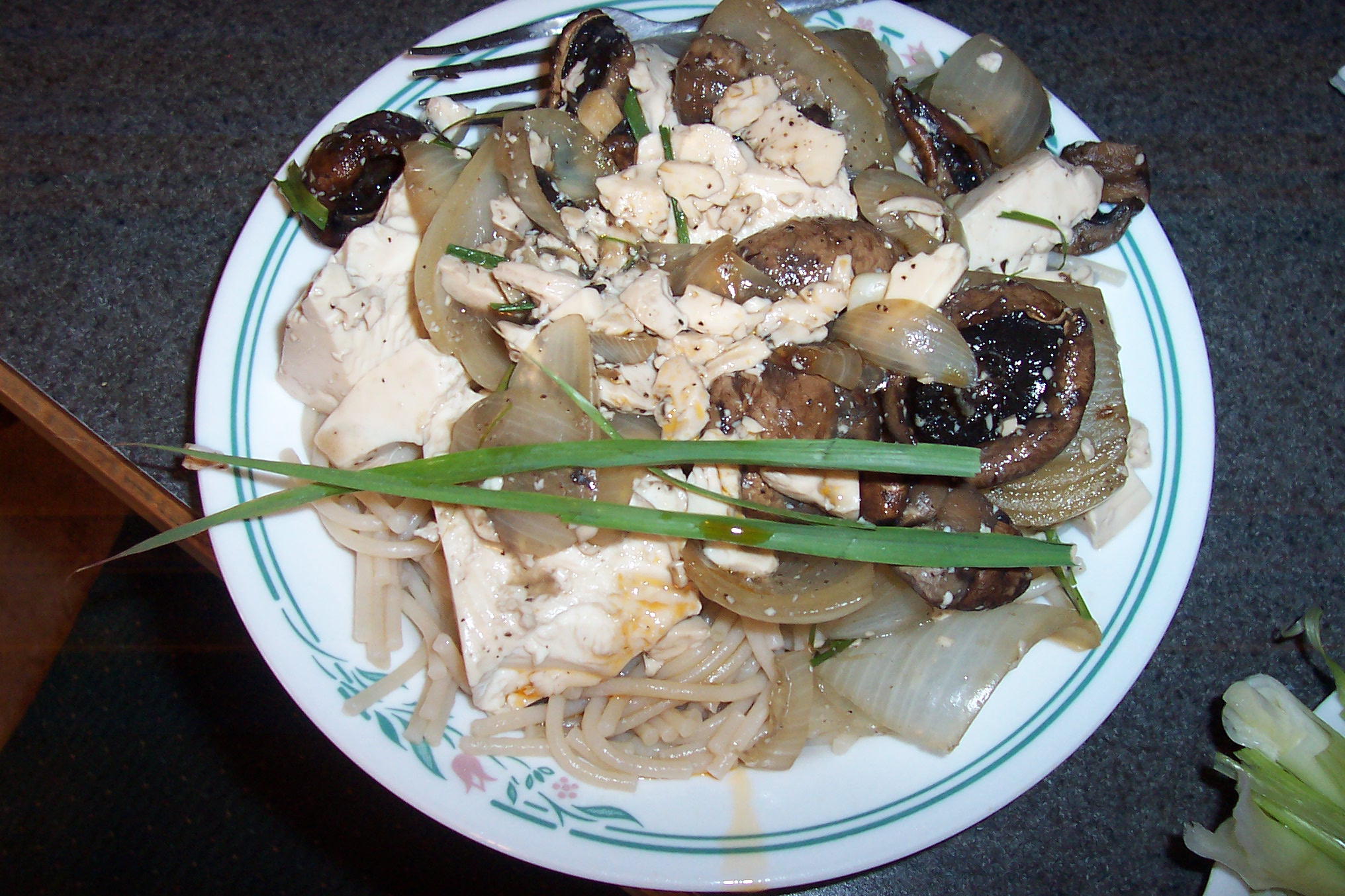
The above is Brown rice noodle stir fry with garlic, onions, tofu, Ginger and Crimini mushrooms.
Prep time: 30 minutes
All you do is wash the mushrooms, steam them, (not fully submerged) in water for about 5 minutes, (no oil was used in cooking.) Crumble the tofu, steam the sliced onions, garlic, and shred some fresh ginger.
Add a touch of rice vinegar, black pepper, and some Bragg’s liquid Aminos. Go easy on it; it is strong like soy sauce, (but with much less sodium.)
The above is some summer squash and a vinegar based dip for Romaine lettuce. The squash (along with others of the same plant {Gourd} family is excellent for summer time. These have high water content and are helpful in staying hydrated. It just so happens that summer squash, melons and cantaloupe are in season during the hottest time of the year when it is most important to stay hydrated. How about that!?
Hummus on whole-wheat bread and a Portobello patty garnished with fresh salsa. Who says veg food isn’t tasty!?
Prep time: 20 minutes
All you do is wash the mushrooms, grill, or steam in a bit of water for about 10 minutes.
Prepare the hummus. There are many hummus recipes; the most healthy, and fastest is one that does not use Tahini, (lots of extra fat calories.) Just blend a clove of garlic, Garbanzos, pepper, lemon juice and a bit of season salt. Some people prefer Cumin or liquid smoke in their hummus, purely a matter of preference. Personally, I don’t care for cumin in my hummus, but liquid smoke is good.
The above is one of my favorites. I call it “Italian Bisque” It is more of a summer treat, because I only use garden fresh tomatoes, and Italian basil from my herb garden. Italian basil, (hence the name) goes especially well with tomato zing, olive oil, garlic, black pepper, and is classic for any Italian dish. This particular time, I used brown rice noodles, but this can modified to use any sort of pasta.
This dish tastes especially good with olive oil. I trust my activity level enough to allow myself to splurge here. 🙂 Anyone trying to watch their cholesterol or weight though, may want to omit the olive oil here.
The Portobello patty was served with sides of lightly steamed Swiss chard, and a vinegarette Romaine lettuce dip.
Classic summer meal: Corn on the cob, garden grown Collards, (lightly steamed) a few Walnuts, Flax seeds (excellent plant source of Omega 3 fatty acids,) and red potatoes.
Prep time: 25 minutes
Wellness Diaries Indian Cuisine, lentils, Brown rice with Fennel, curry and fresh East-Indian lemongrass!
Prep time: 45 minutes (Brown rice takes longer to cook.)
You can cook the rice and lentils (about 25 minutes,) the night before, refrigerate, and simply put the ingredients together. Just spice to taste. Fresh Indian lemongrass, really does add a lemon flavor, and it is exquisite with Indian dishes! If you can find the plant in the spring, growing it is well worth it! This came fresh from my herb garden.
This one is a fun, tasty and creative idea you can try with a cantaloupe. Almond milk inside the cantaloupe bowl with brown rice. Notice how it was also outside on the front porch? See, you’re getting the idea, a half hour breakfast on the porch, you get natural light and a nutritious, hearty first meal of the day.
Get your notebook and pen. You ready?
Record your weight, and take a before photo prior to your beginning the designated two week period. (The differences in only two weeks may be slight, but you will see them!) In addition, take subsequent before and after photos. That is, before starting each step and after starting each step. As you graduate from each step, you will feel like you have climbed to new wellness heights and the photos will show it!
Have your notebook, pen, veg meals and snacks ready, set your two weeks and GO!
After you have successfully committed to and finished the two week period, you can go through what you wrote in your wellness diary, and all that you have learned, and decide just what your most suited approach to a long term plant-based diet will be. In the book, I wrote that you can begin anywhere toward wellness. However, nothing affects all things like food does. The plant-based diet is an effective first step in reclaiming your health. This is why it is the first of the steps, as part of the foundation to wellness.
Record, observe, have fun!
After the two weeks is finished and you have decided what plant-based is for you, you can then move on to the other steps one at a time. While you may skip ahead and take what you like from each step, it is most effective to start from the beginning and work your way through each step, following the exercises and committing to your wellness journey one step at a time.
Through each step, remember to write your observations and the new things that happen to you in your wellness diary.
Go through with your plan now, and come back to this after the two weeks.
What did you find out about a plant-based diet? How did you feel during the two weeks? What changes in yourself did you notice? Notice that you are starting to feel a sense of strength and confidence? I would venture to guess that your photos are showing that also. Over the past two weeks, your body has shed a lot of stored junk and is feeling that wonderful sense of returning to your natural state-health. You have also replaced the junk with nutritious, hearty, nutrient packed plant-foods. Your body is thanking you for this. This is the sense of well-being that you feel returning to you now that you have finished the designated two week time frame. You feel less stressed, worried and a sense of lightness. So much in fact, that you feel ready for some activity. This is the next step: activity and exercise.
Step 2:
Activity and Exercise
Sleep and a plant-based diet are at the foundation of The Wellness Triangle. Exercise is at the top point of the Wellness Triangle, don’t confuse exercise at the top, with sleep, which forms the foundation since exercise is placed in step 2.
After the two week period of plant-based foods, the body has rid itself of much excess junk, and has gone through a basic detox. It has then replaced the junk with all the good, nutrient dense plant foods you have given it. You have taken the vital first step and your body feels ready to move, as it was designed to do! Now that you are feeling more how you are supposed to feel, (that is, GOOD!) You have a lot more energy! You actually have enough energy that you want to move and exercise! Are you ready for some fun?
Bike, rollerblade, dance, garden, walk the dog, play soccer, kick the can, basketball, ski, walk, hike, swim, jog. There is no end to the possibilities of new activities you can try now that you have the energy!
Exercise is important for all levels of wellness. Physical activity is both fun and is incredibly good for the human body. As it was once thought, people do not have to exercise themselves to exhaustion for hours at a time to achieve optimal health. About an hour a day of physical activity is good for your health.
The Wellness Diaries approach is to keep activity and/or exercise simple, as part of a clutter-free life and making it a natural extension of one’s lifestyle. Look what you can do here:
Activity: Gardening, walking the dog, kick the can,
Exercise: thirty minute bike ride, walk the dog, calisthenics, isometrics with a partner, or light strength training, dancing, martial arts, Tai’chi, Yoga.
Commit to at least an hour of physical activity each day. You can add more later if you want, but start with an hour and see how it feels.
After a week of an hour each day of exercise, set a day aside, (you can do half a day if that’s all your life allows at this time,) where YOU are the “vehicle to take you there.” On that day, or half day, commit to going to the places you need to be via your own two feet, bike, or skateboard, doesn’t matter. You are the fuel. If you live where things are far away and need to break the distance up some such as walking to the bus stop to catch the bus the rest of the way, this counts.
This is not a wild haired idea. You will find how much more appreciative you become of energy expenditure, both your own, and other sources such as gasoline for your car, which on this day you cannot use. 🙂 You will find that you also respect nature and the earth and that you are more mindful of the energy spent that comes from earth be it, carbohydrates for you, electricity for your home, or gasoline for your car. You will find that you more fully grasp all energy as precious. All energy, gasoline, carbohydrates, electricity, in some form, come from the earth.
Just as I mentioned in The Wellness Diaries, after a few weeks of this, you will begin to realize on this day how much money you saved.
Let’s look at the ways: On this one day per week, you didn’t spend any gas money driving, you saved wear and tear on your car. If you walked to the grocery store, you most likely have learned not to buy extra stuff that you really don’t need or want on this day, because you are aware of the energy expended by you as the fuel to carry it back home. So, you are getting exercise, sunshine, natural light, fresh air, interaction with people, animals and the outside world. You are not contributing to pollution. You are not spending extra gas money, and you are not putting additional wear and tear on your car. See why in The Wellness Diaries, I called this going back to basics in my own way? This is a modern approach to incorporating timeless, primitive modes into my own lifestyle.
See? Do you see now why it is said that what is good for you, is also good for the planet, and is also good for your pocketbook? You are probably feeling the same amazing feeling I did when I discovered this for the first time. How does it feel? Write all thoughts and observations.
In committing to this one day per week, you will fully understand energy and just what it means to squander energy away. Most of all though, you will receive exercise, fresh air, sunshine and interaction with friendly strangers and other living things. You will realize that these things contribute to an entirely different level of wellness for you, while helping you to save some money and benefit the earth all at the same time.
Consider all the possibilities you could incorporate into your life: What can you do on this one day where you are the vehicle? Here are some ideas that you may consider:
* Walk to the store. You can take reusable shopping bags, and a small hand cart.
* Walk to the post office to mail those letters.
* Walk or bike ride to the library or to a theater
* Bike to work
* Walk to neighbor’s house, drop by to touch bases.
Since the human body is designed to move and exercise, when we do so, we sleep much better, deeply and of adequate length as we are supposed to. Since you have now replaced the junk in your diet with nutrition that your body needs, you then felt like exercising, and both of these contribute to you sleeping better, the other corner of the Wellness Triangle foundation. See the wellness cycle? See how each step of wellness feeds into and influences the others? Isn’t it amazing?!
Step 3:
Sleep
Sufficient sleep in both quality and duration is essential to well-being. It is the second corner of the foundation of the Wellness Triangle. (The first is a plant-based diet.) You will realize how great it feels to get enough sleep and find your most suited sleep time and rhythm.
Sleep must not be forgotten as a part of wellness. Sleep, (or lack of) affects a person’s state of health. Regular, adequate sleep makes a person more productive, mentally alert, helps them to enjoy life and helps the body and mind to heal and repair. Studies have shown that sufficient sleep, both in quality and duration is also significantly beneficial for mental health.
Most people need from 6-9 hours of sleep per night. Your body loves rhythm. Strive for rhythm with your sleep. Go to bed at the same time each night and awake at the same time each morning, even on the weekends. Allow yourself some time to adjust to this sleep routine.
Get your wellness diary ready and begin to track your sleeping habits, just from where you are right now in life and your current habits. Don’t worry if they are not yet where they should be. Learning to improve them is the purpose of this exercise. Track the times you went to bed, and the times you woke up for three consecutive days. Over the course of those three nights, how was your sleep? How many hours did you sleep? How did you wake up, alarm, or naturally, or did someone or something wake you up? Write these down and come back to this article when you are finished.
What did you find out? How did you do? Are you doing pretty well? Are you a sleep dummy that needs some serious help? 🙂
Next step: Aim to get eight hours of sleep for one week. (You can increase or decrease this later as needed; this is discussed later.) Monitor this for one week. Aim to wake up naturally. Here is an exercise to help you find out at what time you naturally wake up: On a weekend, (or night when you don’t have to work the next day,) go to bed only a half hour earlier than usual, and see what time you wake up naturally, without an alarm. For example, on a Saturday night, you could try sleeping from 10pm-6am. If 6am is too early for you, you could try 11-7, or even 12-8. For those who really like to wake up early, you could try 9-4. The starting point is eight hours; so we are using 10-6 as the example for learning your preferred sleep rhythm. The important thing is that you monitor what time you went to bed, and what time you woke up naturally. How many hours was this? Record all details in your wellness diary.
Now, try this eight hour time frame for one week. In only one weeks’ time, you will be able to tell if you are not getting enough sleep. You will also be able to tell if the eight hours is a bit too much and you can adjust the time you go to bed accordingly.
If, at the end of the week you are tired and are not getting enough sleep, try going to bed earlier, say at 9:30 each night. Don’t try to make up for it in the morning, by sleeping in. This will just confuse you and your body’s rhythm. If needed, add extra hours to the evening when you go to bed. If 9:30pm-6am is still not enough, aim for 9 pm each night. When after adding hours in the evening you still wake up naturally at the same time, you are finding your body’s preferred sleep rhythm. Be patient with yourself, this process takes time. Finding a sleep rhythm is gradual.
If need be, spend extra time and effort in training yourself to wake up naturally without an alarm clock. Waking up naturally is far more conducive to rhythm and a good nights’ sleep than the harsh sound of an alarm to jerk you from a crucial stage of deep sleep. (Allow yourself some time to do this and be patient with yourself.)
Additional tips for sleeping well:
Go to bed ready for bed. Give yourself a small window (about a half hour) between your activities of the evening and actually crawling into bed. For example, don’t land in bed feeling like a whirlwind that spent the last hour rushing to get ready for the next day. Spend a half hour prior to lying down for sleep actually relaxing and winding down. You could read something relaxing, or you could lightly massage your feet, or ask a loved one for a massage. You could do some light muscle stretches, or a half hour of meditating, or just sitting quietly. It’s not as important what you do as long as you give yourself this half hour time to sufficiently wind down in preparation for sound sleep.
* Keep your bedroom and bed, cool, quiet and free of clutter. Also keep bedroom décor, simple, relaxing, inviting and not overly stimulating.
* Avoid too much liquid for at least two hours prior to bed time. You can take a small, (about 4 oz.) glass of water at bed time, but avoid too much liquid, or your sleep patterns will be disturbed by waking up to go to the bathroom.
* Avoid food for four hours before bed time. A very light bedtime snack is fine.
* Keep your bedroom as dark as possible when it is time for sleeping. Drapes and blinds with dark colors to absorb any light work well for this.
* Invite your spouse, partner or roommate to join you with your new plan. If they do not wish to join you, inform them of your trial period so that they can help you in making any adjustments necessary, such as reducing noise by a certain time, being aware of your designated time to be in bed, etc.
* Avoid talking too much a half hour prior to bed time. Talking a lot can stimulate your mind and make you feel anything from excited, to frustrated, or stressed. Remember that the idea prior to bed time is preparing yourself for sound sleep. Especially avoid stressful topics such as work or school deadlines or financial stresses. Avoid stimulating your mind and thoughts. This is the time to clear your mind.
Finding your body’s preferred sleep rhythm can take a month or more; it is a gradual process. Don’t force or strain. Be patient with yourself. You will find though, that it is one month very well spent!
Step 4: Outside Time
There are three main parts of the benefits of outside time. They are specified; I refer to each as:
*Direct sunshine (vitamin D)
*Natural light, (benefits even when not in direct sun)
*Time spent in nature
Let’s look at the options.
Look at how much you can do just from the front porch. Here is my humble herb garden with Italian basil, chives, Sage and Rosemary.
How much can you do from the front porch? You may be surprised at the variety of things you can do from this very place while benefitting from being outside.

Here’s something I would bet that you haven’t done since you were a kid-watch clouds. Try it, as you take some outside time. They really are amazing!

More wonders just from the front porch! Beautiful isn’t it? Go outside! Get some natural light. Enjoy the beauty around you.
There is benefit in merely being outside. You are exposed to natural light. If you are exposed to direct sunshine for at least twenty minutes, you reap another benefit, which is direct rays of the sun. Direct sunshine helps the body to make vitamin D-so crucial to health and well-being. ***Please note: While time in the sun is good, becoming a leather back is not. Take care not to overdo a good thing; don’t get sunburned. During the times of day, (and peak seasons) when the sun is at its’ most intense, use caution and ease into sun exposure. Twenty minutes at a time may be a good place to start. If you are going to be in direct sun for longer than this, you can always wear long sleeves, a hat, and long pants, (cool, light colors,) as a natural sun shade, while still receiving natural light. Don’t over do it though.
There is still benefit from natural light and being outside even while beneath the shade of a tree, patio, awning or any place not exposed to direct sun. Time spent in the early morning or evening hours before it gets dark counts for natural light also.
You should strive for a minimum of two hours of natural light per day. Three or four hours is even better. When I tell people this, they usually laugh. Their theme is something along the lines of: “who in the world has time for that?” Well, you would be surprised with what you can do. And always remember that Vitamin D is crucial for every system in the body. It is like a wonder substance. Vitamin D helps you to feel, look, perform and be at your best. The most natural and effective way of getting vitamin D is some time in the sun.
***Please note: When I refer to three or four hours of natural light being ideal. This does not mean three or four hours of direct sunlight. This specifically means this suggested amount of total time in natural light, both direct and shaded. For example, in October, when direct sun is not as likely to burn in short durations, you could spend 45 minutes in direct sun gardening, walking the dog, etc. Then, you could spend two hours and fifteen minutes studying, drawing, chatting with a friend or loved one, resting in a hammock, etc in the shade.
Then in June, when the sun is most intense, twenty minutes in direct sun will probably suffice for vitamin D, and two hours can be spent in the shade; both, adding up to total time exposed to natural light. Avoid sunburn.
What if, say, one Saturday in mid June when the sun is at it’s most intense and of the longest duration, you walk in the morning for thirty minutes? If this was between 8 and 10 am, you got your vitamin D dosage for the day, (as long as you weren’t doused with SPF 45 sunscreen.) Say you walked these 30 minutes from about 9:30-10am AM. You received a healthy amount of direct sun, which has helped your body to make vitamin D. The rest of the two hour minimum, can count as natural light. This includes shade of a tree, awning, or in the early morning hours, or mid-evening prior to the sun going down.
*** Notes about winter: There are still some things you can do in receiving some natural light that you can do in the winter time. Winter time in many parts of the world is so cold, and people are so bundled up, that skin exposure to the sun, coupled with an already reduced intensity in the angle of the sun, makes absorbing enough vitamin D much less feasible in winter. This can present a challenge for many in surviving the winter and avoiding the winter blues. One thing you can do though to help with this is eat raw sunflower seeds! They are one of only a few plant sources of vitamin D. Eat them and enjoy, but as with anything don’t over do it. It is this plant that actually turns to follow the path of the sun throughout the day, amazing! Some vitamin D is stored in the seeds. Stock up on raw sunflower seeds for winter. During winter, you still benefit from being outside in the natural light, even if you are bundled up. The natural light benefits your eyes., (**no direct sun, or glare.) Strive to avoid glasses when you can at this time of year, allow the natural light benefit to absorb through your eyes, but use caution. Don’t burn your eyes in reflective glares of the sun on the snow.
Never forget that there are some sunny and somewhat warmer days in the winter. Make some of these days your outside days. As always though, use balance. Spending too much time outside in the natural light in the winter can be self-defeating, because your rhythm can start to cause your body to behave like it is spring time in late January! You may start to try to go faster and stronger than what is available for the season. Listen to your body and always, always apply balance (which varies according to individual need). Take it easy as you learn, and come to know thyself.
Deprivation of natural light is a relatively new discovery in terms of health, but it should come as no surprise. Typical, modern lifestyles are a contributor to declining health in many ways. The typical modern lifestyle also makes it hard to receive adequate amounts of natural light. Natural light exposure is based on intensity and duration and is measured in light units that I will not go into here. For these purposes, strive for a bear minimum of two hours per day. Three or four hours is that much better.
Here are some ideas for getting in some natural light time:
* Reading or studying on the patio, beneath a tree, or awning
* Walking, or cycling instead of driving (this gives you some activity too.)
* People watching in a park
Just about anything done outside, whether exercise or sedentary, can count as “natural light time.” (Obviously the point of this step is to get natural light,) but by all means, you may have fun combining it with exercise too. You can get creative, and you will probably find that it is more effective to combine exercise with natural light time. What ways can you come up with of receiving natural light? Get creative, have fun. Where can you combine and balance shaded light and direct sunlight? Where could you add some activity to both? Write them in your wellness diary, and set a date that you will start, and time slots of when you will do the various activities outside.
One reaps the benefits of outside time by the absorption of natural light anytime they are outside, even on their front porch. If your porch happens to face south (in the northern hemisphere,) you have the added benefit of direct sun on your porch for a big portion of the day. On your own porch, you not only get you not only get natural light, but it counts for “vitamin D time” too. See the difference? See the possibilities?
Interesting side note: Look at all the wellness contributors to a sound sleep:
Natural light and also vitamin D, exercise, nutrition, general feeling of well-being. See why sleep is part of the foundation? See the wellness cycle? Each aspect of wellness feeds into the others.
There may be benefits to merely being outside, but the benefits increase to triple fold if you are outside in nature. This is why I listed this step separately.
Step 5: Time in Nature
There are added benefits of time in nature; that is, the sense of truly being “unplugged” and at least to an extent, at one with nature. This has an entirely different level of value. Go and experience nature as often as you possibly can. These wild places may be few and far between, but even if you can find small patches of them within the city, use them! Also, take time to truly get away. Go to national parks, in the mountains or forest camping. Disconnect. Unplug. Take some time to experience and take it in through all five senses. Smell the mountain air, crisp and clear. Hear the sounds of birds and wildlife, the running water, or the ocean waves. Take the time to touch the leaves, to feel the earth beneath your feet, and to see the wonders of nature, the beauty of creation. It really is awe inspiring.
Take some time. Always record your discoveries and experiences in your wellness diary.
Consider the possibilities that are endless.
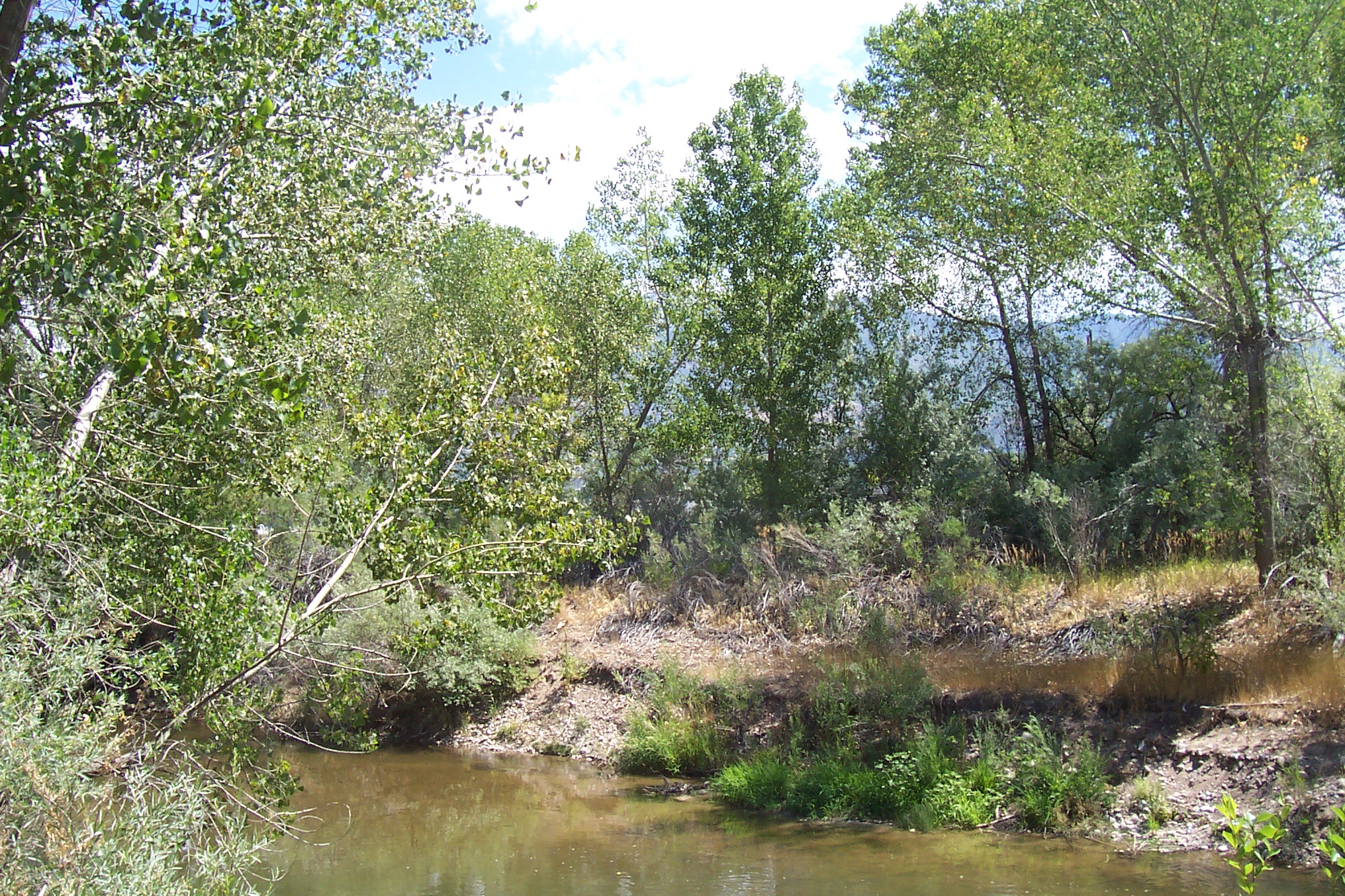
… or on any nature walk path you can find, a new world awaits. It is the world of being outside amongst nature.
One of my favorites: Populus tremuloides in the mountains.
For time outside, there really is something for everyone. If you live in the middle of a big city, go to a park, start an urban gardening venture, or join a community garden. There are things you can do to feel a connection to the earth. We all need this to one extent or another. Still, go as often as you can to wilderness and wild places, (National parks, etc,) camping, hiking, where you can truly absorb the goodness of the natural world for some time.
The therapeutic value in time spent among the natural world is being understood more fully all the time. Time outside in nature seems especially beneficial for people with brain disorders, (mental illness.)
Some examples of possibilities for outside time, activity combinations:
If you were to bike one day per week to places you needed to go, what benefits do you receive? Write these down.
If you take a morning walk, merely around the block, what benefits do you experience? Let’s list some: sunshine and natural light time, fresh air, exercise, interaction with natural things, (trees, birds, animals,) even if not among a natural, or wild place. Did you nod to a stranger, or stop to pet their dog, or boa constrictor? 🙂 List all benefits.
**Note: although not a step of this guide, in The Wellness Diaries, I mention pets as part of well-being. There really is something to giving to another being, providing care for a pet, or even a houseplant, (may be surprising to some, but not me,) teaches love, nurture and compassion like nothing else does. The bonding that takes place through the daily walk with the dog, or feeling the purr of a cat is therapeutic in a whole new way. At least in part, this sharing and bonding that takes place with person and animal is a timeless thread of connection to creation. Learn to appreciate, or re-appreciate your pets as cherished members of your family.
In what ways can you get out among nature? Is there a hiking trail, a beach, or a river walk close to your home? How often can you go there? List them, and write down a goal for how often you will go to this place.
You will notice that after spending more time outside, you more fully comprehend energy. Not only the energy required by you, to do what you do, but all energy, from gasoline, to carbohydrates, to electricity to sunshine. Furthermore, you will develop a greater appreciation for nature, and you will become more tuned in to what clear, crisp air smells like, compared to polluted air, silence VS noise, surrounded with life, over being surrounded with things that have no life, (buildings, cars, traffic lights and street signs, pavement, etc.)
The natural light will help you to sleep better, deal with stress more effectively, and help you to relax. Because you sleep better, you are up for some activity, which also contributes to sleeping soundly also, as part of the foundation of the Wellness Triangle. See the wellness cycle? See how sleep, diet, exercise, outside time all play into one’s state of well-being of spirit, mind and body?
The forgotten Basic Need: Air
Air is a need so basic that it is often unmentioned as a basic need. While one could last for a few days without food or water, one could not last two minutes without air.
As thoroughly explained in The Wellness Diaries, my primary mode of transportation is any combination of bus, bike and boots. I have spent a lot of time outside, and it is easy to tell when the air is clean or not.
When the air quality is the Yellow or red zones, it feels like I am breathing dust, gritty particles; that, I am. On those days, I feel about as helpless as a fish in polluted waters. On the other hand, I feel like jumping for joy when I walk outside and the air feels, smells and looks crisp and clean. On this note, I wish to point out that here, where I live in Utah, the air quality has been in the “green” zone for over a month. It is absolutely “breath-giving” beautiful!
Step 6: Unplugged Time:
Set aside one day per week as your day to “unplug.” This can be any day you choose. For example, it is most fitting into my lifestyle to have Sunday as my unplugged day. This I do. Here, the term “Unplugged” specifically means gadgets where your hands are continuously involved with it, such as computers, mobile phones (texting), and Ipod. “Unplugged” doesn’t mean use no electricity. Unplugged helps you make the distinction between the overuse of electronic gadgets, and the step in taking a conscious rest from these. On this day, do something at a different pace. Work with your hands; do arts, crafts, writing, drawing, gardening, make something, play chess, watch a movie with a loved one, (With a movie, you are watching, but your hands are not constantly involved with the electronic gadget,) etc.
Do this on the same day every week. Once you commit to this day, you are committed. Treat yourself and reap the rewards! Be aware of ways that you can combine different steps, but don’t deny what you have committed to. For example, you may decide to spend some computer time outside in mild weather on your front porch with laptop. This way you are getting natural light, outside time, but you are not unplugged. Don’t count it as such, Commit.
After a few weeks of this, designate some time of your choosing, but at least for 14 days to set aside as “seasonal unplugged time.” This is a time to go about your life at a restful pace. It is a great time to work with your hands, travel, garden, or relax with loved ones. During that vacation time from work you have wanted to use can be a great time for this. Take on a deliberate, different pace, one that is slower and more settled. Feel yourself be refreshed and invigorated over this time. Enjoy! You deserve it.
Step 7: Live On Purpose!
See the new you?! If you have gone this far through all the steps, you have noticed many changes. Notice how strong you feel, determined, inspired, and how on purpose. Take note of how completely alive you feel; notice how planted in the light you feel. Congratulations! This is not by accident. This is your natural state of health and well-being, and it is how you are supposed to feel. You have worked for it, you have earned it and you deserve it.
Now is a great time to begin writing down dreams, aspirations and making goals toward the life you want. You have the strength, determination and focus to do this now. How does it feel? What can you do? Like a tree, what is the potential growth for that type of tree? The sky is the limit.
Give yourself a pat on the back, enjoy the new you and Live your dream. You are intended to live intentionally. Life is conscious.
I hope you have enjoyed this guide. Have fun with the steps and in chipping away the excess to reveal the new, ever-expanding you!
Feel free to contact me with comments or questions.
Thank you for reading.
Owen
The Wellness Diaries is available at Amazon.com and Barnesandnoble.com
http://www.barnesandnoble.com/w/the-wellness-diaries-owen-staples/1115240040?ean=9781475987409


